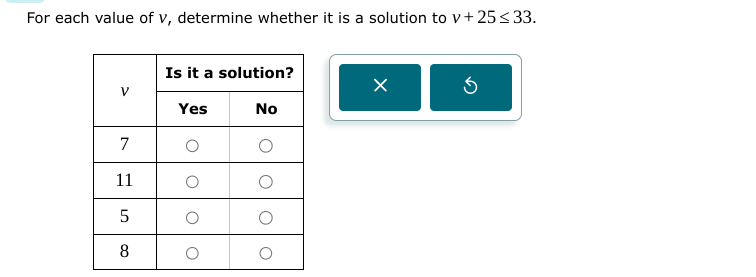For each value of v, determine whether it is a solution to v + 25 ≤ 33.

Understand the Problem
The question asks us to substitute each given value of 'v' into the inequality 'v + 25 ≤ 33' and determine whether the inequality holds true. If it does, then 'v' is a solution; otherwise, it is not.
Answer
The solutions are v = 7, v = 5, and v = 8. v = 11 is not a solution.
Answer for screen readers
| v | Is it a solution? |
|---|---|
| 7 | Yes |
| 11 | No |
| 5 | Yes |
| 8 | Yes |
Steps to Solve
- Substitute v = 7 into the inequality
Substitute $v = 7$ into the inequality $v + 25 \le 33$:
$7 + 25 \le 33$ $32 \le 33$
Since 32 is less than or equal to 33, $v = 7$ is a solution.
- Substitute v = 11 into the inequality
Substitute $v = 11$ into the inequality $v + 25 \le 33$:
$11 + 25 \le 33$ $36 \le 33$
Since 36 is not less than or equal to 33, $v = 11$ is not a solution.
- Substitute v = 5 into the inequality
Substitute $v = 5$ into the inequality $v + 25 \le 33$:
$5 + 25 \le 33$ $30 \le 33$
Since 30 is less than or equal to 33, $v = 5$ is a solution.
- Substitute v = 8 into the inequality
Substitute $v = 8$ into the inequality $v + 25 \le 33$:
$8 + 25 \le 33$ $33 \le 33$
Since 33 is less than or equal to 33, $v = 8$ is a solution.
| v | Is it a solution? |
|---|---|
| 7 | Yes |
| 11 | No |
| 5 | Yes |
| 8 | Yes |
More Information
An inequality includes values that are "less than or equal to" the provided value.
Tips
A common mistake is to incorrectly perform the addition. Another common mistake is misinterpreting the inequality symbol. For example, thinking 36 ≤ 33 is true.
AI-generated content may contain errors. Please verify critical information